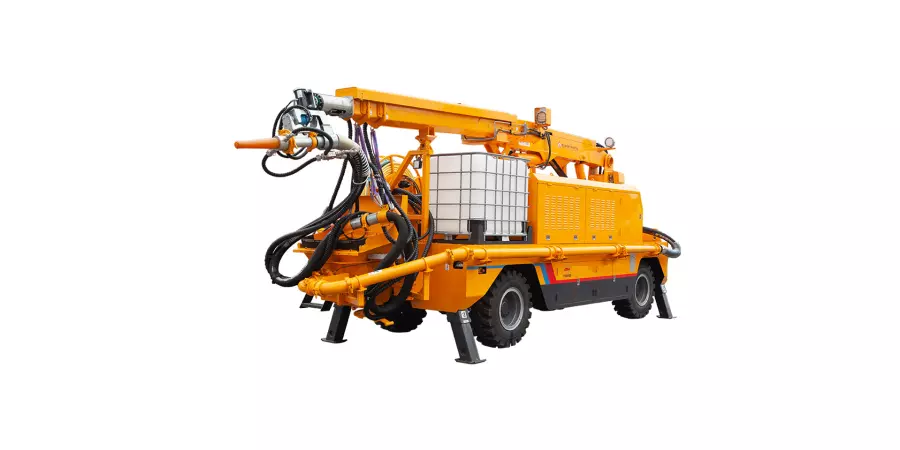Markets

Hydraulic Products Used in Wet Shotcreting Machines
Wet shotcreting machines rely on a robust hydraulic system to deliver precise control, high-pressure pumping, and durability in abrasive environments. Below is a detailed breakdown of the key hydraulic components and their roles:
1. Hydraulic Pump
Function: Generates high pressure to power the hydraulic system, crucial for pumping wet concrete through hoses.
Types:
Axial Piston Pumps: Preferred for high-pressure applications (e.g., 20–30 MPa).
Gear Pumps: Used in auxiliary circuits for lubrication or cooling.
Features: Designed to handle abrasive slurries with hardened materials to resist wear.
2. Hydraulic Motor
Function: Drives the mixing mechanism or concrete pump rotor.
Applications:
Radial Piston Motors: Provide high torque for mixing agitators.
Gerotor Motors: Compact motors for auxiliary functions like hose reel rotation.
3. Hydraulic Cylinders
Function: Controls the movement of the spraying nozzle, boom, or stabilizers.
Design:
Double-Acting Cylinders: Enable precise extension/retraction for nozzle positioning.
Telescopic Cylinders: Compact design for confined spaces.
Durability: Hard-chromed rods and abrasion-resistant seals (e.g., polyurethane).
4. Control Valves
Directional Control Valves: Direct hydraulic fluid to actuators (e.g., Parker D1VW series).
Proportional Valves: Enable variable flow/pressure for precise spray control.
Pressure Relief Valves: Protect the system from overpressure (set to 110% of max pressure).
5. Hydraulic Power Unit (HPU)
Components:
Reservoir: Stores hydraulic fluid (100–500 L capacity) with baffles to reduce turbulence.
Filters: Multi-stage filtration (βₙ≥1,000 @ 10 µm) to remove concrete particles.
Coolers: Maintain oil temperature ≤60°C (air- or water-cooled).
6. Hydraulic Hoses and Fittings
High-Pressure Hoses: Reinforced with steel wire to withstand 30+ MPa pressures.
Quick Couplings: Enable fast assembly/disassembly for maintenance.
7. Accumulators
Function:
Bladder/Piston Type: Absorb pressure spikes during sudden valve shifts.
Emergency power backup for critical functions (e.g., nozzle retraction).
8. Seals and O-Rings
Materials: Nitrile (NBR) or Fluorocarbon (FKM) for chemical/abrasion resistance.
Applications: Critical in pumps and cylinders to prevent leaks in abrasive environments.
9. Sensors and Monitoring Systems
Pressure Transducers: Monitor system pressure in real time.
Temperature Sensors: Prevent overheating in continuous operation.
IoT Integration: Remote diagnostics for predictive maintenance.
10. Specialized Components
Swivel Joints: Allow 360° nozzle rotation without hose kinking (30+ MPa rated).
Concrete Pump Rotors: Hydraulically driven to push slurry through delivery hoses.
Key Challenges and Solutions
| Challenge | Solution |
|---|---|
| Abrasive Wear | Hardened pump components and ceramic-coated seals. |
| Contamination | Multi-stage filtration and frequent fluid analysis. |
| Heat Buildup | High-efficiency coolers and synthetic hydraulic fluids. |
Leading Brands
Pumps/Motors: Bosch Rexroth, Kawasaki, Danfoss.
Valves: Sun Hydraulics, HydraForce.
Cylinders: Enerpac, Caterpillar.
Maintenance Best Practices
Fluid Management: Use ISO VG 46/68 oil with regular replacement (every 1,000 hours).
Filter Replacement: Change at ΔP ≥0.5 bar pressure drop.
Seal Inspection: Check quarterly for wear or leaks.
Technological Trends
Electro-Hydraulic Systems: Proportional valves + PLCs for automated spray patterns.
Energy Recovery: Regenerative circuits to reuse deceleration energy.
Biodegradable Fluids: Environmentally friendly options for sensitive job sites.
Summary
Wet shotcreting machines depend on a precision-engineered hydraulic system to deliver high-pressure concrete spraying with reliability. Core components include pumps, motors, cylinders, valves, and advanced filtration, all designed to withstand abrasive conditions. Innovations like IoT monitoring and electro-hydraulic controls are driving efficiency, while robust maintenance practices ensure longevity in demanding environments like tunneling and mining.
